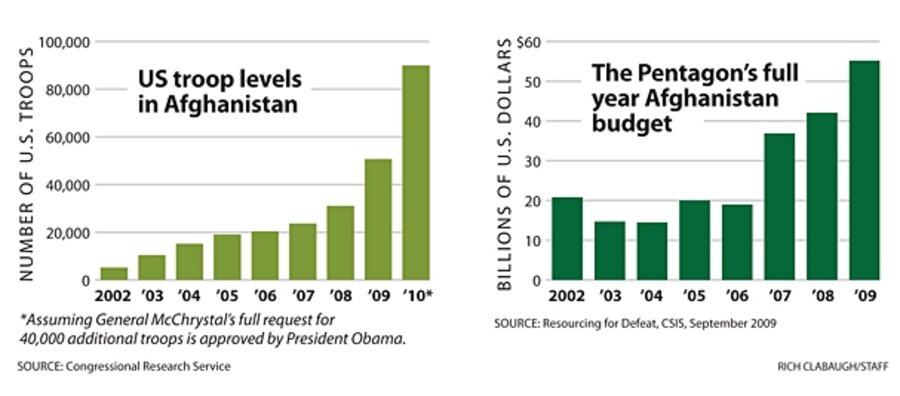If McChrystal gets his Afghan surge, how many troops will be there?
Loading...
Gen. Stanley McChrystal, as part of his comprehensive strategy review for the war in Afghanistan, has asked President Barack Obama for up to 40,000 more troops. It's not clear he'll get them – President Obama is concerned about spending more lives and money propping up the deeply corrupt government of Afghan President Hamid Karzai – but the pressure to make a decision on the matter is mounting.
No matter what Obama decides, the United States commitment has already dramatically expanded during eight years of war. What began as a tiny operation using air power and satchels of money – carried in some cases by Special Forces soldiers on horseback to Afghan warlords willing to fight the Taliban – has expanded during every year of the war.
The attached graph on troop levels shows monthly averages. In Afghanistan, where heavy winter snows make much of the country impassable, there are much greater month-to-month fluctuations in US troops levels than in Iraq. In 2008, for instance, the US had 26,600 soldiers on the ground in January and 48,250 in June. The 2010 figure is the Monitor's own back-of-the-envelope calculation for a monthly average assuming 40,000 more troops are approved.
We were unable to find comparable figures on the development of other nations' military commitments to the NATO-led mission in Afghanistan. In June of 2009, when there were 56,000 US troops in Afghanistan, there were about 32,000 soldiers from more than 30 different countries. Britain was the second-largest contributor to the force, with 9,000 troops on the ground.
Spending has also steadily increased, though this is not fully reflected in the other attached graph since it does not include “supplemental” congressional budgeting. But the annual planned spending in Afghanistan has risen for each of the last three years. The true spending totals are much higher.
McChrystal and his advisers have expressed some frustration with the focus on the possible troops surge. While they say they need more soldiers and Marines to get the job done, they point out that the new boots on the grounds will be deploying a new counterinsurgency strategy that is the real key to success. At its core is the belief that shifting the focus from killing and capturing Al Qaeda and the Taliban to protecting the Afghan people from the depredations of a corrupt government, friendly warlords and the Taliban alike will stabilize the country and prevent any future Afghan takeover.
Beltway pundits who favor the war have been touting McChrystal's approach, with New York Times columnist David Brooks writing on Friday that "only the full counterinsurgency doctrine offers a chance of success" in Afghanistan. In his column he approvingly cites a recent report by Andrew Enterline and Joseph Magagnoli of the University of North Texas that found, in his words, that "since World War II, counterinsurgency efforts that put population protection at their core have succeeded nearly 70 percent of the time."
The trouble is, he didn't read the report carefully, which is neatly summarized in two pages here.
True, the two scholars found in assessing data from 66 20th-century counterinsurgencies that armies have succeeded in counterinsurgency campaigns 67 percent of the time when they changed strategy toward a "hearts and minds" approach similar to McChrystal's.
But the timing of the switch was crucial, in their finding, yielding this key caveat: "Some pundits and analysts have claimed the new strategy in Afghanistan misses the early 'window of opportunity' necessary to make a difference in the outcome of the conflict, one in which the insurgency is entrenched and Afghan suspicion of foreign forces becomes heightened.
"Our analysis indicates that all foreign states that shifted to a hearts-and-minds strategy after eight years of counterinsurgency ultimately failed to defeat the insurgents, a pattern that does not bode well for Afghanistan."





